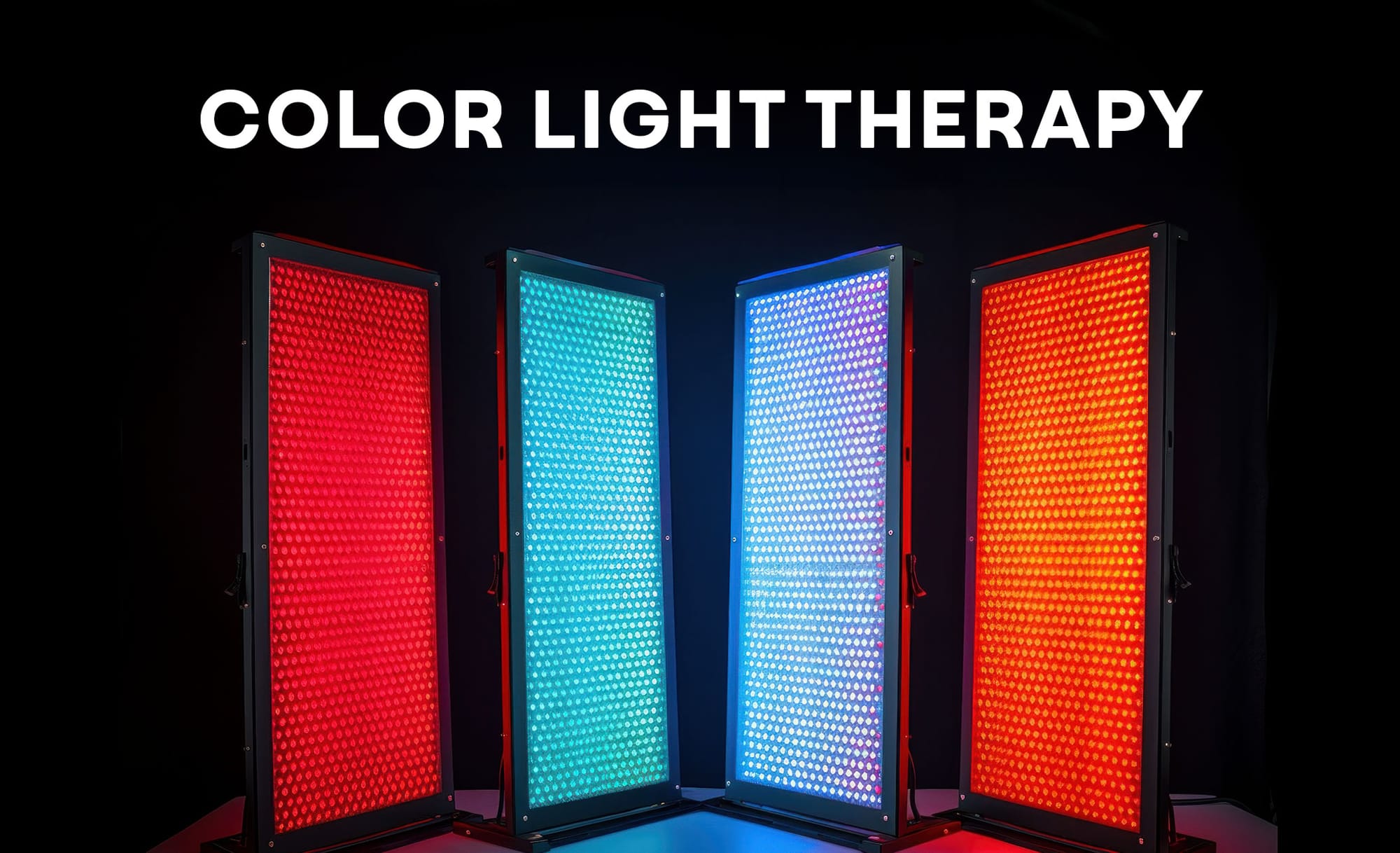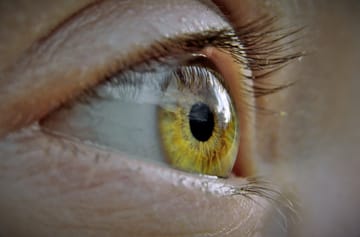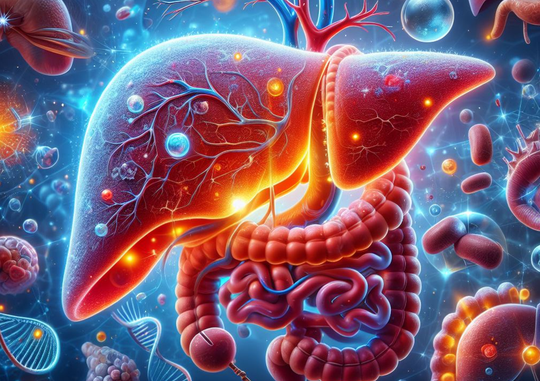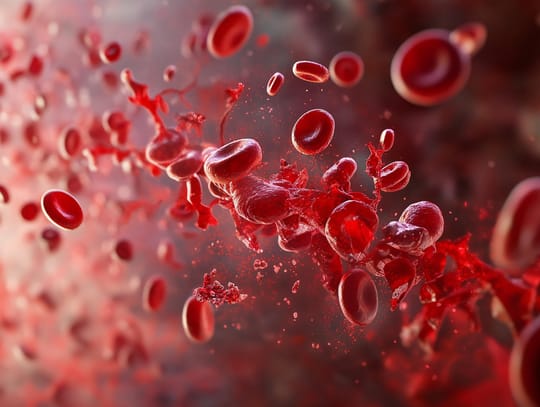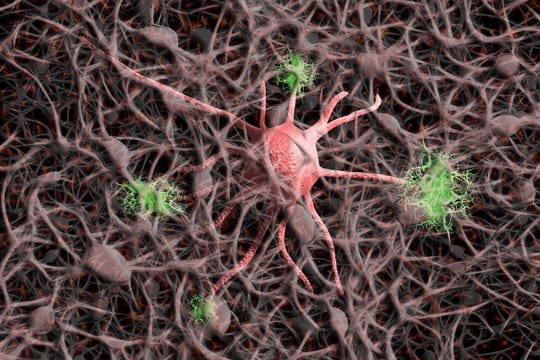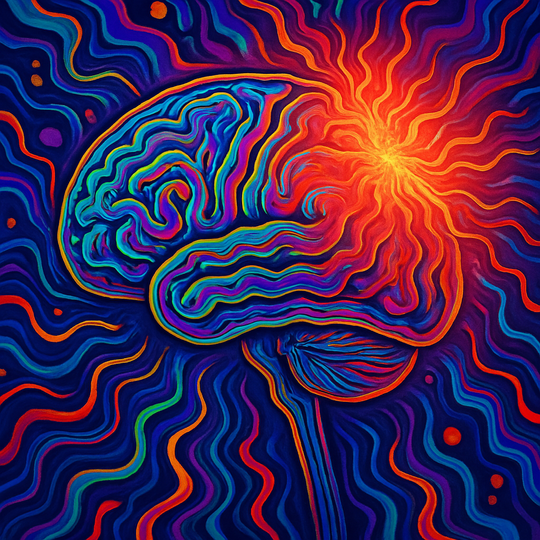In this blog post I'll talk about color light therapy or "chromotherapy". Chromotherapy is a specific form of light therapy where you're exposing your body to different colors of light, such as blue, green, yellow (amber), red, and others.
To explain this topic in more detail, I'll go over the effects of different wavelengths. In physics, light is measured in wavelengths. So, blue, red, green, yellow, or purple all have a different wavelength from a physics perspective.
If you're interested in more of a deep dive on specific topics though, I recommend checking out some earlier blog posts of mine, such as:
- Blue Light Therapy: Everything You Need To Know
- Green Light Therapy Benefits: The Very Promising Science
- What Is Red Light Therapy?
- Red Light Therapy Wavelengths Benefits: The Ultimate Guide
- Red Light Vs Blue Light Therapy: Benefits And Differences
- 590nm Wavelength Health Effects Ultimate Guide (Amber Or Yellow Light)
But let's explore the topic in more detail first:
What Is Color Light Therapy?
So what is color light therapy? Color light therapy generally uses LEDs, although technically it can also be achieved through other light sources. The benefit of LEDs here is that it can emit light around very specific wavelengths.
So, an LED can emit light around 630nm red light, for instance, and will barely emit any light at 620nm or lower, or 640nm or higher. And, because LEDs can emit light at very specific wavelengths, you'll get the benefits of these wavelengths.
Why does that matter?
Well, the health effects of different wavelengths varies. So 630nm red light has different effects than 660nm red light, for instance. And 810nm near-infrared light has different health effects than 850nm near-infrared light - although there's a scientific discussion about the extent of the difference.
Nevertheless, I'll assume here that different wavelengths have different health effects. For simplicity sake, I'll talk about all the colors of the rainbow here, which are often included in color therapy. These are violet, blue, green, yellow, orange, and red - and everything in between.
Let's consider what effects these different types of light can have on your body:
The Benefits Of Color Light Therapy
So let's talk about the benefits of color light therapy. Here are some examples of benefits, starting with blue light.
Blue light can:
- Counter skin conditions such as acne, atopic dermatitis, and psoriasis (1; 2; 3; 4; 5; 6; 7).
- Help you deal with Seasonal Affective Disorder (SAD) and some types of depression (8; 9; 10).
- Tell your body it's daytime, thereby helping increase wakefulness (11; 12; 13; 14; 15).
- Other benefits such as enhancing dental care and boosting your serotonin levels (a brain signalling compound that makes you feel all is well) - read more in my blue light therapy blog.
Green light:
- May improve skin health, although more research is needed (16; 17; 18).
- May improve wound healing (19; 20).
- Enhances circulation (21; 22).
- Boosts boost fat loss quite significantly (23; 24; 25).
- Helps you deal with cellulite (26).
- If you'd like to learn about more benefits, read my blogs about green light therapy.
Yellow or amber light:
- May boost recovery after fractures (27; 28).
- Aids skin quality in many different domains, such as countering redness and inflammation, preventing hyperpigmentation, lowering scar formation risk, and slow down skin aging (29; 30; 31; 32).
- Has quite a significant positive effect on eye health (33; 34; 35; 36; 37).
- Again, if you want more information, read my blog about yellow or amber light therapy.
Red light therapy, lastly:
- Counters excess inflammation, both locally and systemically (38; 39; 40).
- Impedes many types of pain, whether that's osteoarthritis, neuropathic pain, pain as a side effect of cancer treatment, fibromyalgia, and more (41; 42; 43; 44; 45; 46).
- Boosts workout performance and recovery (47; 48; 49; 50; 51).
- Enhances your energy levels and boosts circulation (52; 53; 54; 55; 56).
- If you want to learn more, read my blog on red light therapy benefits. Examples here are sleep quality, mood, countering overall disease risk in many instances, helping you feel better, and more!
Suffice it to say that many different colors can have many different health effects! Reality is a bit more complicated though, as different types of "blue" light, such as violet in the low 400nms range and blue in the high 400s, have different health effects.
The same is true for different types of green and red light, for instance. But generally my depiction above is correct! So enjoy these led light therapy color benefits.
Let's move on to another topic often discussed in relation to color therapy:
7 Color Led Light Therapy Chart Explained
Color therapy charts are scientifically arbitrary and don't have any specific meaning at all. At least, if you consider the scientific journal which I'm quoting from above, you won't find any publications on color therapy charts.
Of course, color therapy charts are nice as a heuristic because it helps people get a sense of overview and perhaps (flawed) understanding. But in reality, in both physics and medicine, the only entity that really exists are wavelengths of light, that have specific effects.
Colors don't exist from a physics perspective and are a construct of the human brain. So the light therapy color chart is interesting but not correct.
Specific Color Light Applications
So let's consider a few color light applications. People often ask:
- "What color light therapy for eczema?"
- "Is violet light color therapy different than blue?"
- "What color light therapy for acne?"
- "Which color light therapy for anti-aging?"
- "Does infrared sauna color light therapy work?"
- "What about color light therapy for migraines!?"
The answer here, is to go back to my discussion of wavelengths. I'm sorry if it's continually the same answer but please keep in mind that I'm simplifying the discussion for you.
For instance, with eczema, there are likely benefits from red, yellow, and blue light therapy, so you can use these colors in your life and get benefits there. Blue light is especially helpful for acne, and red light to some extend. UV light is very helpful for acne too but is generally not considered part of color therapy.
And, yes, color therapy inside a sauna will still work. And for migraines, green light therapy helps really well.
What matters is the wavelength, the power output (how much light is emitted), and the exposure time. More color therapy isn't always better - as you'll see in the next section:
The Risks Of Using Color Light Therapy
Almost all health interventions carry inherent risk - especially when misused. For instance, if you overdo it, red light therapy can make you tired, can increase symptoms, and make you feel jittered or anxious. For completeness' sake, check the video on red light therapy dosing below on this topic:
Other wavelengths can have side effects too, such as green or yellow light - although very little research has been carried out on them. Blue light is most famous for having side effects, such as keeping you from sleeping (by surpressing melatonin) or making you feel stressed or jittery (because of increasing wakefulness) (58; 59; 60; 61).
Deteriorating eye health is another problem with blue light - although that's more because of indoor lighting and computer screens (62; 63; 64). The best general rule here is not to overdo the chromatherapy and just follow the instructions of the product you've bought. Generally, companies think pretty well about dosing.
Is Red Light The Most Healing Color?
Generally, red light and also near infrared light (which is often not included in color therapy because it's invisible to the human eye, are considered the most healing yes.
The reason for that conclusion is that there are about 10,000 studies carried out on red light therapy currently (57). Red light therapy has enormous health benefits across the board. Not all of these 10,000 studies are carried out in humans - there are tons of animal and foundational laboratory studies - but still with 1,500 human studies they're still impressive. And most of the human studies have positive outcomes as well, with an estimated 90% positive rate.
But, please do keep in mind that unlike the name suggests, red light therapy uses both red and near-infrared light. Hopefully though, in the coming years and decades, more research will be carried out on blue and green and yellow light (and their subdivisions), so that you'll learn a lot more about the health effects of these wavelengths.
How To Get Started With Color Light Therapy?
So, there are very few high-powered chromotherapy devices on the market today. So what you'll have to do is often buy dedicated devices that offer blue, green, or amber wavelengths at a sufficient power output level.
I'll cover a few of these devices below - first up, a red light therapy panel that offers yellow or amber light at 590nm. I'm talking about the Mito Red MitoRPOX range here, that our very own Alex Fergus has reviewed here:
The MitoPRO X is one of the best panels on the market currently, and adds amber light to your exposure. Code ALEX5 saves you on that panel.
Next up, there's the LightpathLED Diesel range, which you can get in a version that emits lots of blue light:
Alex Fergus reviews the non blue light version of the LightpathLED Diesel XL above but you can also get a blue light version. Discount code ALEX saves.
Next up, there's the PlatinumLED BioMax 900 if you want a small amount of blue light added to your red light therapy:
The PlatinumLED BioMax 900 won the 2024 comparison series by Alex. If you're interested in this panel, click to go to the PlatinumLED website and a discount code is generated for you.
Lastly, if you want spot treatment, consider the Hooga, which emits blue, yellow, red and near-infrared light:
Use discount code ALEX for a Hooga product. Hooga also sell pure green, yellow, blue, and orange handheld units that you can find under Hooga website, by going to "Color Therapy".
Conclusion: Chromotherapy Is Very Promising, But More Research Is Needed!
Fortunately, we've got quite some studies now showing that blue, yellow, green, and amber light can have health benefits that most people didn't know about years ago. And, for red and near-infrared light, there's literally thousands of studies showing positive effects.
Hopefully, we'll get tons of studies into violet, blue, green, yellow and amber as well in the coming years. And because current studies are promising, I suspect that many other benefits will be shown in time for these colors. Time will tell. In the meantime, I've listed all the best color therapy devices below:
Items Mentioned
- Mito Red MitoPRO 1500X - code ALEX5 saves
- LightpathLED Diesel - code ALEX saves
- PlatinumLED BioMax 900 - a discount code is generated after you click the link.
- Hooga 4-in-1 device - code ALEX saves
- Hooga Green Migraine Bulb - code ALEX saves
Found This Interesting? Then You Might Like:
- Start Here - Light Therapy 101 & Buyers Guide
- Discount Codes, Deals & Recommendations - Red Light Therapy
- Blue Light Therapy: Everything You Need To Know
- Green Light Therapy Benefits: The Very Promising Science
- What Is Red Light Therapy?
- Red Light Therapy Wavelengths Benefits: The Ultimate Guide
- Red Light Vs Blue Light Therapy: Benefits And Differences
- 590nm Wavelength Health Effects Ultimate Guide (Amber Or Yellow Light)
This is a post by Bart Wolbers of Lighttherapyinsiders. Bart finished degrees in Physical Therapy (B), Philosophy (BA and MA), Philosophy of Science and Technology (MS - with distinction), and Clinical Health Science (MS), has had training in functional medicine, and is currently chief science writer.

